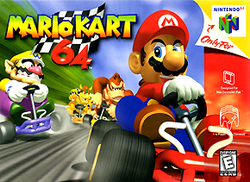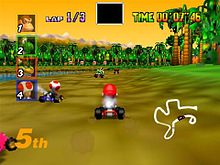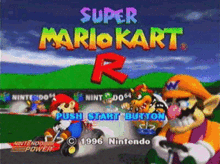- Mario Kart 64
-
Mario Kart 64 
North American boxart, featuring Mario, Wario, DK, and Bowser.Developer(s) Nintendo EAD Publisher(s) Nintendo Director(s) Hideki Konno Producer(s) Shigeru Miyamoto Composer(s) Kenta Nagata[1] Series Mario Kart Platform(s) Nintendo 64, Nintendo iQue, Virtual Console Release date(s) Nintendo 64
Virtual Console[2]
Genre(s) Racing Mode(s) Single-player, multiplayer Rating(s) Mario Kart 64 (マリオカート64 Mario Kāto Rokujūyon) is a racing game developed and published by Nintendo for the Nintendo 64. It is the second installment in the Mario Kart series. It was released in 1996 in Japan and in 1997 in North America and Europe. In January 2007, Mario Kart 64 was released on Nintendo's Virtual Console service for the Wii.[2] It was the first game that the ESRB gave the E rating instead of the K-A rating.
Mario Kart 64 is the sequel to Super Mario Kart for the Super Nintendo Entertainment System. Changes from the original include the move to 3D computer graphics and the inclusion of four-player support. Players take control of characters from the Mario universe, who race around a variety of tracks with items that can either harm opponents or aid the user. The move to three-dimensional graphics allowed for track features not possible with the original game's Mode 7 graphics, such as changes in elevation, bridges, walls, and pits. However, the characters and items remained 2D pre-rendered sprites.
The game was critically well received and was a best seller. Mario Kart 64 was one of the first games in the series to feature Charles Martinet as the voice of both Luigi and Wario.
Contents
Gameplay
There are eight playable characters: Mario, Luigi, Bowser, Princess Peach, Wario, Yoshi, Toad, and Donkey Kong.
There are 16 tracks that are based on different locations seen in Mario video games: Luigi Raceway, Moo Moo Farm, Koopa Troopa Beach, Kalimari Desert, Toad's Turnpike, Frappe Snowland, Choco Mountain, Mario Raceway, Wario Stadium, Sherbet Land, Royal Raceway, Bowser's Castle, D.K.'s Jungle Parkway, Yoshi Valley, Banshee Boardwalk, Rainbow Road. Each track has a unique shape, and may contain various obstacles, hazards, and short-cuts.
Items are picked up by players when they drive through item boxes. Each item can be used to an effect such as launching shells at opponents, consuming a mushroom to gain a temporary boost in speed, or placing bananas on the ground for opponents to later slip on. AI-controlled racers are able to use all the items except for red and green shells.
By hopping and then going around a corner while tilting the control stick in the direction of the turn, a player earns a small speed boost by drifting. There is also an advanced drift technique (as just mentioned) that allows players to turn against the direction of their drift for a speed boost.[3]
The game is compatible with the N64 Controller Pak, but only to save track ghosts in the Time Trial mode, which requires 121 pages, almost the entire standard controller pak. All other data is stored in-cartridge.
Game modes
There are four different forms of play in the game: Grand Prix, Time Trial, Versus, and Battle.
In Grand Prix mode one to four human players compete against computer players in a tournament that takes place over four courses[4]. At the end of each race points are awarded based on what order the player finished in. These points are added up as the tournament continues, and at the end of the tournament, the player with the most points wins. Difficulty level is measured by engine size: 50(3.05CID[5]), 100, or 150 cc. There is an unlockable difficulty called 'Extra', allowing players to race on mirrored tracks.
In Time Trial mode players race around the track by themselves in an attempt to improve their time and set a new record for the course. Players start time trial mode with three mushrooms (speed bursts) and cannot obtain any additional items. During time trial players may select to race alongside a 'ghost' who will mimic the movements of the player from his/her previous run.
Versus mode entails two to four players racing head-to-head on a single track without any AI characters on the track, with mobile bombs located around the track.
Battle mode is different from the other modes in that the aim is, rather than to complete a race as quickly as possible, to attack other human-players with items. There are four courses that can be selected and two to four people can engage Battle mode. The Block Fort arena is known for its high replay value. At the start of the battle each player begins with three balloons attached to their kart. Each time a player is damaged, by, say, running into a banana, or being hit by a shell from another player, the player loses one of his or her balloons. When a player loses all of his balloons, he is eliminated from the match. In a one-on-one match the game ends and the cart with at least one balloon left is declared the victor. In three or four player matches the eliminated character becomes a bomb and may now run into other players, exploding and taking away from them one of their balloons. Battle mode differs from Grand Prix or Versus in that those towards last place receive the best items in Grand Prix and Versus, but in Battle mode these items are generated randomly.
Playable characters
Players can choose from eight characters to operate their kart. Koopa Troopa and Donkey Kong Junior, both of whom appeared in Super Mario Kart, did not return for Mario Kart 64, replaced by Donkey Kong and Wario. In pre-release screenshots, a Magikoopa was playable,[6] but before the game's final release the Magikoopa was replaced by Donkey Kong.
Characters are divided into three categories: lightweights, middleweights, and heavyweight. Mario and Luigi are balanced middleweight characters; Peach, Yoshi, and Toad are lightweights with quick acceleration; Wario, Bowser, and Donkey Kong are heavyweights with responsive steering. Lightweights are faster in acceleration and in maximum speed, but heavyweight characters have better turning and can bash into lighter characters, spinning them out of control.
Development
Production of the game began in 1995 under its original title Super Mario Kart R,[6] but the title was later changed to Prevent Copyright issues with the Sega Saturn Game Sonic R[citation needed]. The first major public viewing and demo of the game was during the Shoshinkai Software Exhibition on November 24, 1995.[7]
In "Mario Kart R", the playable characters were Mario, Luigi, Princess Peach, Yoshi, Wario, Toad, Bowser and a Magikoopa, possibly Kamek.
Prior to the final release of the game, a feather item was playable in Super Mario Kart R as it was in Super Mario Kart.[6]
Music
The soundtrack to Mario Kart 64 was composed by Kenta Nagata, the first major game for which he composed.[1] Both the introduction music for Mario Kart 64 and the music from the course Bowser's Castle were remixed and used in the music video game Dance Dance Revolution: Mario Mix for the Nintendo GameCube.[citation needed]
Re-release
Almost ten years after the original release, Mario Kart 64 was re-released on the Wii's Virtual Console in January 2007 for 1000 Wii Points. However, due to the lack of a Controller Pak, it is impossible to save ghost data, as was possible in the Nintendo 64 version.[2]
Reception
Reception Aggregate scores Aggregator Score GameRankings 87%[8] Metacritic 83 of 100[9] Review scores Publication Score Edge 8 of 10[10] Electronic Gaming Monthly A[11] GamePro 5 of 5[12] GameSpot 6.4 of 10[13] IGN 8.1 of 10[14] Nintendo Power 4.33 of 5[8] Mario Kart 64 received generally positive reviews. The game has an average review ratio of 87% on Game Rankings, including reviews from IGN and GamePro, and magazines such as Electronic Gaming Monthly.[8] IGN stated, "Though the single-player mode is a bit of a step back from the SNES original, Mario Kart 64 still offers one of the best multiplayer experiences to be had on Nintendo 64."[14] GameSpot insisted that though the graphics and sound of the game are impressive, the gameplay is too easy and lacks depth.[13] In GameSpot's re-review of the Virtual Console release the reviewer criticized its sound, lack of ghost-saving, and graphics, saying the latter had "aged rather poorly."[15] The game placed 17th in Official Nintendo Magazine's 100 greatest Nintendo games of all time.[16] Mario Kart 64 sold approximately 5.5 million copies in the United States and 2.24 million in Japan.[17][18] Joystiq reported in February 2009 that the game had sold over nine million copies worldwide.[19]
Merchandise
Mario Kart 64 included a line of action figures that were released worldwide in 1999 as part as the Video Game Super Stars line created by Toy Biz. Series one included Mario, Bowser, and Yoshi, while series two included Ghost Mario, Luigi, Donkey Kong, and Wario.
References
- ^ a b "Kenta Nagata". Square Enix Music Online. http://www.squareenixmusic.com/composers/nintendo/nagata.shtml. Retrieved 2011-09-25.
- ^ a b c "Mario Kart 64 on VC". Nintendolife.com. http://vc.nintendolife.com/games/n64/mario_kart_64. Retrieved 2011-09-25.
- ^ "Mario Kart 64 Translated". IGN. http://ign64.ign.com/articles/060/060464p1.html.
- ^ http://www.funtrivia.com/en/VideoGames/Mario-Kart-Games-13041.html
- ^ http://www.asknumbers.com/CubicCentimeterToCubicInch.aspx
- ^ a b c "Super Mario Kart R [N64 - Beta]". Unseen64. 2008-04-04. http://www.unseen64.net/2008/04/04/super-mario-kart-r-64-beta. Retrieved 2010-08-13.
- ^ Liedholm, Marcus (1998-01-01). "The N64's Long Way to completion". Nintendo Land. Archived from the original on 2008-08-28. http://replay.waybackmachine.org/20080503135511/http://www.nintendoland.com/home2.htm?n64/n64.htm. Retrieved 2008-03-27.
- ^ a b c "Mario Kart 64 Reviews". Game Rankings. http://www.gamerankings.com/htmlpages4/197860.asp. Retrieved 2008-05-02.
- ^ "Mario Kart 64 (n64: 1997): Reviews". Metacritic. http://www.metacritic.com/games/platforms/n64/mariokart64?q=mario%20kart%2064. Retrieved 2008-05-02.
- ^ "Edge Online: Search Results". Edge. http://www.edge-online.co.uk/edgedb/search.php. Retrieved 2008-05-02.
- ^ "Mario Kart 64 N64 Review Index, Mario Kart 64 Reviews:". 1UP.com. http://www.1up.com/do/reviewPage?cId=3111925&p=23&sec=REVIEWS. Retrieved 2008-05-02.
- ^ Doctor Zombie (2000-11-24). "Review: Mario Kart 64 for N64 on Gamepro.com.". GamePro. http://www.gamepro.com/nintendo/n64/games/reviews/509.shtml. Retrieved 2008-05-02.
- ^ a b Ward, Trent (1997-02-06). "Mario Kart 64 for Nintendo 64 Review - Nintendo 64 Mario Kart 64 Review". GameSpot. http://www.gamespot.com/n64/driving/mariokart64/review.html. Retrieved 2008-05-02.
- ^ a b Schneider, Peer (1997-02-20). "IGN: Mario Kart 64 Review". IGN. http://ign64.ign.com/articles/150/150502p1.html. Retrieved 2008-05-02.
- ^ Mario Kart 64 for Wii Review - Wii Mario Kart 64 Review
- ^ "20-11 Official Nintendo Magazine". Official Nintendo Magazine. http://www.officialnintendomagazine.co.uk/article.php?id=7258. Retrieved 2009-02-25.
- ^ "The Magic Box - US Platinum Chart Games.". The Magic Box. 2007-12-27. http://www.the-magicbox.com/Chart-USPlatinum.shtml. Retrieved 2008-04-29.
- ^ "The Magic Box - Japan Platinum Chart Games.". The Magic Box. 2007-12-27. http://www.the-magicbox.com/Chart-JPPlatinum.shtml. Retrieved 2008-04-29.
- ^ Ransom-Wiley, James (February 26, 2009). "Guinness pours out its Top 50 Games of All Time". Joystiq. http://www.joystiq.com/2009/02/26/guinness-pours-out-its-top-50-games-of-all-time/. Retrieved February 22, 2010.
External links
- Official Nintendo Japan Mario Kart 64 site
- Mario Kart 64 at the Open Directory Project
- Mario Kart 64 Time Trial Players page
- Mario Kart 64 guide at StrategyWiki
- Mario Kart 64 at the Super Mario Wiki
Mario sports games Golf games Tennis games Mario Kart series Soccer/Football games Baseball games Mario & Sonic Single games Cameo appearances Categories:- 1996 video games
- Mario Kart games
- Nintendo 64 games
- Mario Universe games
- Nintendo Entertainment Analysis and Development games
- IQue games
- Virtual Console games
- Action figures
- Nintendo 64 racing games
Wikimedia Foundation. 2010.


